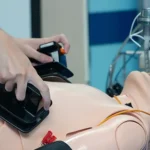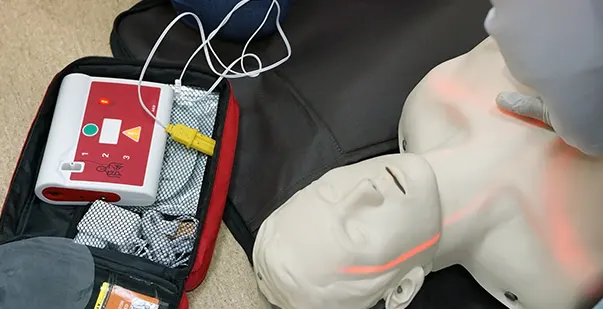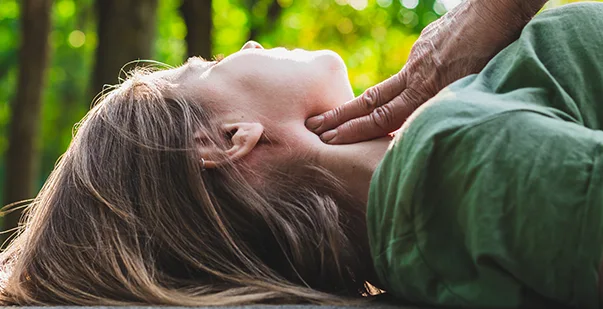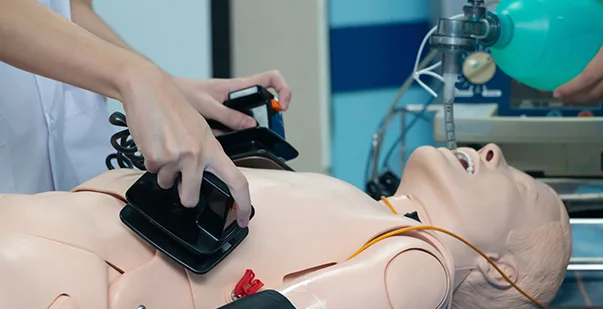Basic Life Support (BLS) certification is an important credential for healthcare providers, emergency responders, and everyday people who want to be ready in a crisis. With this certification, you’ll learn life-saving techniques such as CPR, using an AED, and helping someone who’s choking. Not only can these skills save a life in a healthcare setting, but they can also render vital assistance during emergencies outside of the hospital.
In recent years, the demand for BLS certification has grown considerably. This is because of the fact that In the United States, more than 350,000 cardiac arrests occur outside of hospitals each year.
The increasing popularity of BLS certification is obviously because of the growing realization among people about how immediate and effective help can be provided to save life. The more aware people become, the more important it seems to be for appropriate healthcare workers as this has become a major prerequisite in their job profile and other non-healthcare individuals interested in being prepared to step up when needed, to get themselves a BLS certification.
In this article, we will guide you through the 10 steps to obtain your BLS certification, making it easier for you to gain these important skills and contribute positively in emergencies.
What Is a BLS Certification?
Basic Life Support (BLS) certification is a course that teaches healthcare professionals and public safety personnel how to respond to cardiac and breathing emergencies in adults, children, and infants. BLS certification covers topics such as:
- Cardiopulmonary resuscitation (CPR)
- Using automated external defibrillators (AEDs)
- Relieving airway obstructions
- Critical thinking and problem solving
- Working in a team
BLS certification is essential for those people who are likely to be near or in contact with people with cardiac arrest or other emergencies. You may contact your employer to find out as to whether or not you require a BLS certification.
Should You Pursue an Online BLS Certification?
Basic life support certification is essential for many professionals, including EMTs, nurses, paramedics, pharmacists, and physicians. For those entering nursing programs, completing BLS certification may be a prerequisite, and some nursing programs incorporate BLS and CPR training into their curriculum.
However, BLS certification isn’t limited to these professions. Anyone, regardless of their career or experience, can obtain certification.
Emergencies can occur anywhere, whether at a beach with a drowning victim or at a restaurant with someone choking. Having BLS certification equips you to handle such situations effectively.
Additionally, if you work with the public, BLS training is highly beneficial. Childcare providers, security guards, flight attendants, teachers, and construction workers all stand to gain from acquiring basic life support skills.
How to Get BLS Certification Online
Obtaining BLS Certification varies based on the method you choose, but generally involves a few hours of your time and costs under $50.
Opting for an online course offers a convenient, accessible, and budget-friendly solution for both healthcare professionals and the general public.
Here’s a brief guide to help you get your BLS Certification:
1. Find a Certification Provider
To get BLS certification, the first step is to find a credible provider that offers the training. Many people assume that only well-known organizations offer high-quality BLS courses, but lesser-known providers can also offer excellent training.
For instance, some community colleges and local hospitals provide BLS courses that are just as rigorous as those from major organizations. What’s interesting is that some of these local programs have partnerships with international health organizations, allowing them to incorporate the latest global practices into their training.
For example, a local community center might offer a course that includes recent updates on CPR techniques used worldwide, giving you a fresh perspective on life-saving methods.
2. Choose the Right Course
Choosing the right BLS course is crucial for effective training. You can opt for an in-person class, where you’ll practice skills hands-on with instructors, or an online course, which offers flexibility but may lack immediate practice.
Some providers also offer blended courses, combining online theory with in-person skills sessions. Each format has its benefits; for example, in-person classes allow real-time feedback and practice on mannequins, while online courses let you learn at your own pace and fit into a busy schedule.
Consider what works best for your learning style and availability to get the most out of your training.
3. Register for the Course
To register for a BLS course, you need to visit the website of a recognized certification provider and navigate to their course registration section. Here, you can browse through the available course schedules and select the one that best fits your availability. Once you’ve chosen a course, you’ll need to fill out the registration form with your personal details and payment information. After completing the registration process, you’ll receive a confirmation email with further instructions and access to any pre-course materials.
Interestingly, many people are unaware that some BLS courses offer a “challenge” option, allowing experienced individuals to bypass the full course and directly take the certification exams. This can save time for those who already possess the necessary skills and knowledge.
For example, if you have been working as a healthcare professional and are confident in your BLS abilities, you can opt for the challenge option, complete the exams, and obtain your certification without attending the entire course.
4. Complete Pre-Course Requirements
Completing pre-course requirements for a Basic Life Support certification often involves reviewing study materials or passing an initial assessment to ensure you have a foundational understanding of the concepts.
These pre-course tasks are designed to prepare you for the hands-on training and written exams that follow. Interestingly, some BLS courses include interactive e-learning modules that adapt to your learning pace, providing a personalized experience that enhances retention and understanding.
This adaptive learning approach is not widely known but can significantly improve your grasp of life-saving techniques before you even step into the classroom.
5. Attend the Training
Attending the training sessions for BLS certification is crucial as it combines both theoretical knowledge and practical skills.
During these sessions, you’ll learn essential life-saving techniques such as high-quality chest compressions, rescue breathing, and the use of an Automated External Defibrillator (AED).
Interestingly, many people don’t realize that the correct depth for chest compressions in adults is about 2 inches (5 cm), which is deeper than most expect. This depth is necessary to ensure effective blood flow during cardiac arrest.
The hands-on practice during training helps you master these techniques, ensuring you’re well-prepared to respond in real-life emergencies.
6. Practice Hands-On Skills
Practicing skills in person during BLS training is important for learning how to perform life-saving techniques effectively.
You’ll get the opportunity to perform high-quality chest compressions, rescue breathing, and use an AED on manikins. For example, during a practice session, you might simulate a scenario where someone collapses from cardiac arrest. You’ll perform chest compressions at the correct depth and rate, ensuring effective blood flow, and use the AED to deliver a shock if needed.
This hands-on practice builds your confidence and ensures you’re prepared to respond effectively in real-life emergencies.
7. Pass the Written Exam
Passing the written exam is a key part of obtaining your BLS certification.
This exam tests your understanding of the material covered during the course, including the correct procedures for performing CPR, using an AED, and providing rescue breaths.
Common questions might include the compression-to-breath ratio for adult CPR (which is 30:2), the correct depth for chest compressions, and the steps in the Adult Chain of Survival.
By studying these topics and practicing with sample questions, you’ll be well-prepared to pass the written exam and demonstrate your knowledge of life-saving techniques.
8. Demonstrate Practical Skills
You’ll need to demonstrate your ability to perform BLS techniques correctly in a practical skills test. It ensures you can effectively perform life-saving techniques.
During this test, you’ll be required to show your ability to perform high-quality chest compressions, provide rescue breaths, and use an AED correctly. For example, you might be asked to simulate a scenario where a person has collapsed and is unresponsive.
You’ll need to check for responsiveness, call for help, start chest compressions at the correct depth and rate, and use the AED to deliver a shock if necessary.
This practical demonstration confirms that you can apply what you’ve learned in a real-life emergency situation.
9. Receive Your Certification
After completing your Basic Life Support course and passing the exams, you will receive your certification, often as a card or digital certificate. Interestingly, while many assume the physical card is the most important part, it’s actually the digital version that is increasingly used by employers and institutions due to its ease of verification and less risk of loss.
For instance, some workplaces now integrate digital certificates into their internal systems, allowing instant verification of your certification status through a secure online portal.
This modern approach helps streamline the process and ensures that your certification is always up-to-date and easily accessible.
10. Verify Certification Validity
Once you receive your BLS certification, it’s important to keep track of when it expires. Most BLS certifications are valid for two years. Before this period ends, you’ll need to renew your certification to ensure you stay current with the latest life-saving techniques.
Check the expiry date on your certification card or documentation, and plan to take a renewal course before it runs out.
Renewal courses are often shorter and focus on updates and refreshers, so you’ll maintain your skills and knowledge effectively.
Renewing Your BLS Certification
As mentioned, BLS certification typically lasts for two years. To keep your skills current, you’ll need to renew your certification before it expires.
The renewal process usually involves taking a refresher course, which reviews key concepts and hands-on skills. In some cases, you might also need to pass a brief exam or practical test. Staying up-to-date with BLS ensures you’re prepared to handle emergencies effectively and maintain compliance with job requirements.
It’s a good idea to check with your certification provider for specific renewal requirements and deadlines.
Get Your BLS Certification and Be Prepared
Getting BLS certification is an essential step for anyone wanting to be prepared for emergencies, whether in a professional setting or at home. The process is straightforward, involving selecting a provider, completing a course, and passing an exam. Regular renewal ensures your skills stay sharp and up-to-date with the latest guidelines. Investing in BLS certification not only boosts your confidence but also enhances your ability to make a real difference in critical situations. Don’t wait—take the initiative to get certified and be ready to save lives when it matters most.










